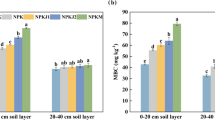Abstract
The reuse of wastewater for the irrigation of farmlands is gaining popularity, and the nutrient leaching associated with wastewater irrigation is becoming a matter of concern. The variability of nitrogen and phosphorus fractions in wastewater-irrigated soil was investigated in both horizontal and vertical directions in Kongjiaxiang, Tongliao, Inner Mongolia, China. The results showed that wastewater irrigation resulted in the concentrations of available N and P being 40.36% and 66.49% higher, respectively, than those with groundwater irrigation. Different forms of N and P exhibited significantly different distribution patterns. Higher concentrations of NO −3 and total available N, as well as of those of Ca-P and total available P were observed near wastewater irrigation channels. Ca-P has a spatial distribution pattern similar to that of available P. The concentrations of NO −3 and NH +4 were the highest in top soil and decreased with depth. The complex interactions between nitrate leaching and nitrogen transformation processes (e.g., nitrification, denitrification, and mineralization) determined the vertical profile of NO −3 . The significant amount of NH +4 loss inhibited its deep seepage. The Ca-bound compound contained more P than other inorganic fractions as a result of high Ca levels throughout the soil profile. The differences in the concentrations of Ca-bound P at different depths could be due to the upward flux or translocation of Ca from subsurface to surface soil and the sequestration of P.
Similar content being viewed by others
References
Finley S, Barrington S, Lyew D. Reuse of domestic greywater for the irrigation of food crops[J]. Water Air and Soil Pollution, 2009, 199(1–4): 235–245.
Morari F, Giardini L. Municipal wastewater treatment with vertical flow constructed wetlands for irrigation reuse[J]. Ecological Engineering, 2009, 35(5): 643–653.
Liberti L, Notarnicola M. Advanced treatment and disinfection for municipal wastewater reuse in agriculture [J]. Water Science and Technology, 1999, 40(4/5): 235–245.
Yi L L, Jiao W T, Chen X N et al. An overview of reclaimed water reuse in China [J]. Journal of Environmental Sciences(China), 2011, 23(10): 1585–1593.
Chen S, Wu W, Hu K et al. The effects of land use change and irrigation water resource on nitrate contamination in shallow groundwater at county scale [J]. Ecological Complexity, 2010, 7(2): 131–138.
Wang Junfeng, Wang Genxu, Hua Wanyan. Treated wastewater irrigation effect on soil, crop and environment: Wastewater recycling in the loess area of China[J]. Journal of Environmental Sciences(China), 2007, 19(9): 1093–1099.
Bond W J. Effluent irrigation: An environmental challenge for soil science [J]. Australian Journal of Soil Research, 1998, 36(4): 543–555.
Kim D Y, Burger J A. Nitrogen transformations and soil processes in a wastewater-irrigated, mature Appalachian hardwood forest[J]. Forest Ecology and Management, 1997, 90(1): 1–11.
Tabatabaei S H, Najafi P. Effects of irrigation with treated municipal wastewater on soil properties in arid and semiarid regions[J]. Irrigation and Drainage, 2009, 58(5): 551–560.
Tiessen H, Moir J, Carter M. Soil Sampling and Methods of Analysis[M]. CRC Press, Florida, USA, 1993.
Olsen S R, Cole C, Watanabe F S et al. Estimation of Available Phosphorus in Soils by Extraction with Sodium Bicarbonate[M]. US Dept of Agriculture, 1954.
Boeckx P, Van Meirvenne M, Raulo F et al. Spatial patterns of delta C-13 and delta N-15 in the urban topsoil of Gent, Belgium [J]. Organic Geochemistry, 2006, 37(10): 1383–1393.
Bolton H, Smith J, Wildung R. Nitrogen mineralization potentials of shrub-steppe soils with different disturbance histories[J]. Soil Sci Soc Am J, 1990, 54(3): 887–891.
Riley W, Ortiz-Monasterio I, Matson P. Nitrogen leaching and soil nitrate, nitrite, and ammonium levels under irrigated wheat in Northern Mexico[J]. Nutrient Cycling in Agroecosystems, 2001, 61(3): 223–236.
Khalil K, Mary B, Renault P. Nitrous oxide production by nitrification and denitrification in soil aggregates as affected by O2 concentration[J]. Soil Biology and Biochemistry, 2004, 36(4): 687–699.
Maag M, Vinther F P. Nitrous oxide emission by nitrification and denitrification in different soil types and at different soil moisture contents and temperatures[J]. Applied Soil Ecology, 1996, 4(1): 5–14.
Smith R, Burns L, Doyle R et al. Free ammonia inhibition of nitrification in river sediments leading to nitrite accumulation[J]. Journal of Environmental Quality, 1997, 26(4): 1049–1055.
Master Y, Laughlin R J, Stevens R J et al. Nitrite formation and nitrous oxide emissions as affected by reclaimed effluent application [J]. Journal of Environmental Quality, 2004, 33(3): 852–860.
Smith R, Doyle R, Burns L et al. A model for nitrite accumulation in soils[J]. Soil Biology and Biochemistry, 1997, 29(8): 1241–1247.
Master Y, Laughlin R J, Stevens U et al. Gaseous nitrogen emissions and mineral nitrogen transformations as affected by reclaimed effluent application[J]. Journal of Environmental Quality, 2003, 32(4): 1204–1211.
Author information
Authors and Affiliations
Corresponding author
Additional information
Supported by Major State Basic Research Program of China (“973” Program, No.2009CB118607) and Inner Mongolia Science and Technology Foundation (No. 2009058).
Yao Hong, born in 1975, female, Dr, associate Prof.
Rights and permissions
About this article
Cite this article
Yao, H., Xue, X., Zhang, S. et al. Evaluation of spatial and vertical variability of nitrogen and phosphorus in sewage-irrigated soil in Tongliao, China. Trans. Tianjin Univ. 19, 241–247 (2013). https://doi.org/10.1007/s12209-013-2030-8
Accepted:
Published:
Issue Date:
DOI: https://doi.org/10.1007/s12209-013-2030-8




